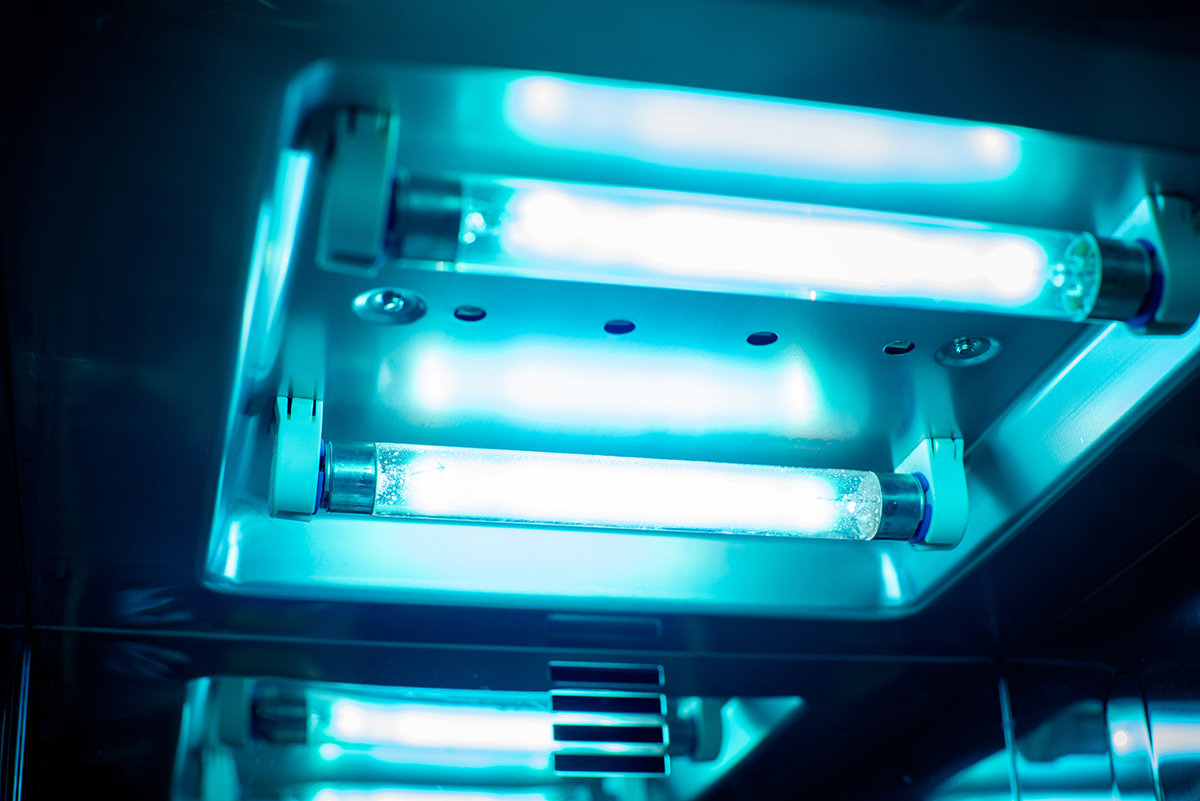Ultraviolet light is a non-thermal surface decontamination technology that is emitted through the use of lamps.
It is split into multiple bands based on wavelength, with the most germicidal and commonly used wavelength of 254nm situated in the UV-C band (200 to 280nm).
UV-C achieves inactivation on a wide range of microorganims by damaging or modifying their DNA, inhibiting their ability to grow and reproduce.
In general, specific mould spores offer the highest resistance to UV-C, followed by bacterial spores, more general moulds, yeasts and bacterial vegetative cells offer the least resistance.
Principles
As UV-C is a surface decontamination technology, inactivation through UV-C can only be achieved on areas of the product that are directly exposed to the UV light.
This property means that areas of the product which overlap, are covered by non-transmissive packaging (e.g labells) or hidden behind other products, will not be in contact with the UV light, and will not recieve any inactivation of microorganisms.
UV-C is used on a range of products such as external packaging or the surface of fruits, vegetable and bakery products and is being used to decontaminate products traveling from low care to high care zones.
In addition to solid products, systems are also available for the treatement of liquids. UV-C processing is widely established for water treatment due to its ability to penetrate far into the liquid. For other liquids with low transmission of UVC light, the germicidal efficiency is highly dependant on the product composition, turbidity, depth of liquid being processed and the concentration of microorganisms and suspended solids in the liquid.
UV systems exist that generate turbulent flow with opaque liquids (low UV-C transmission) that allows for greater product exposure to the light.
Safety and hazards
UV-C irradiation is harmful to human health if in contact with eyes or skin, even when operating at low dosages as continual exposure can build up over time.
The correct PPE should be worn to protect the skin and eyes when systems are operated.
As a result of the ability to reflect off surfaces, UV emmiting lamps are housed in closed off tunnels or containers with cowling on entry and exit points. For larger areas flaps may be used on these points to block UV light. Lamp access points have trip switches to switch off the lamps so that no one can be inadvertently exposed if opened.
Stature and legislation
UV-C is widely employed in the food industry as a decontamination technology for packaging and some food products. Some food sectors and local country legislation may prevent UV from being used for some food products.
Novel food appproval for this technology is only required when the process gives rise to significant changes in the composistion or structure of the foods or food ingredients which affect their nutritional value, metabolism or level of undesirable substance.
So far there are four approved uses of the technology because it substantially increased Vitamin D2 in bread, yeast and mushrooms and Vitamin D3 in milk.
Other information
Low pressure UV lamps (under a vacuum) have no gaseous emission. If the glass lamps were to break, then mercury vapour could potentially be released. Lamp concentrations are typically low (4-10 mg) and in a factory environment (>8m3) the concentration would be lower than the acute exposure limit of 1.7mg/m3 for 1 hr exposure providing enough time to act.
Amalgam lamps absorb much of the mercury so limits the release further. Amalgam lamps are used a lot in water applications. Lamps themselves typically have a life span of 8,000 hours but can vary between 6,000 and 10,000 depending on the lamp type and how the lamps are used. No other consumables are used for this equipment.
Advantages:
-
Non-thermal process avoids impacting product quality due to high temperatures.
-
No residual compounds.
-
No additional decontamination chemicals applied.
-
Simple health and safety measures ensuring the light is well contained.
Limitations:
-
Efficiency of the equipment is highly dependent on the properties of the product being treated. Some products surface structures may influence the maximum reductions possible. .
-
Only surface decontamination is possilbe.
-
The ability of microorganisms to self-repair may allow organisms to survive if subjected to sub-lethal UV-C doses.
-
Possible impacts on product quality (odour taints) at high UV doses for some products.


